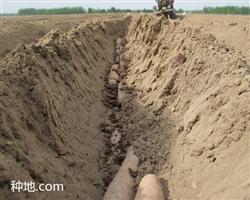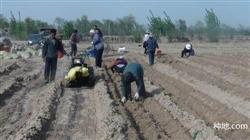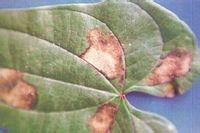How to control diseases and insect pests in yam planting?

How to control diseases and insect pests after planting Chinese yam? The main disease and pest control methods of Chinese yam are introduced as follows: first, agricultural control 1. The selection of disease-resistant varieties is an effective method to control diseases and insect pests of yam. When cultivating disease-resistant varieties, the varieties should be rotated every 2 ~ 3 years, and attention should be paid to the purification and rejuvenation of the varieties. two。 Rotation can reduce or avoid the harm of stem rot and root-knot nematode of Chinese yam. Rotation with corn, wheat, radish, watermelon and other uninfected crops at least once a year; in the old areas where yam is cultivated all the year round, it should be rotated once a year; in conditional areas, flood and drought rotation can be carried out, and the control effect is better. 3. Soil preparation can directly eliminate pathogens overwintering in the soil. Selecting high dry, low humidity, fertile and loose sandy loam for soil preparation in autumn, the diseased remains left on the surface can be turned into the soil, accelerate the decomposition and decay of the diseased bodies, and lose the vitality of some pathogens after freezing in winter and drying in spring. 4. Fertilizing and irrigating yam are fertilizer-loving crops, and rotten organic fertilizer must be applied during soil preparation. Generally, the application of phosphorus and potassium fertilizer is beneficial to the formation of mechanical tissue of Chinese yam and enhance the ability of resistance to pathogenic bacteria. Excessive application of nitrogen fertilizer is easy to cause overgrowth of plants, tender stem and leaf tissue, and easy to get Chinese yam anthracnose. The principle of watering is "no drought, no watering". When watering, clean water sources must be watered thoroughly, there can be no stagnant water in the fields, and drainage should be carried out in time during the rainy season to avoid root rot. 5. The field is clean and the weeds in the field should be eliminated manually. The timely removal of the leaves and stems of the diseased yam can reduce the re-infection of pathogens. When the yam is harvested, the diseased remains, weeds and rotten stems left on the ground should be burned or taken out of the field for deep burial to reduce the overwintering pathogens. Second, chemical control 1. Chinese yam anthracnose harms stems and leaves, causing stem withering and falling leaves. Control method: soak the seed potato with 1 ∶ 1 ∶ 150pod solution for 10 minutes. Spray the first drug with 50% carbendazim 600 times solution when the seedlings are full, and spray the second time 10 days later. From July to August, it was found that 65% Dysen zinc wettable powder 500 times, 50% bacilli special wettable powder 800 times, 50% methyl topiramate 700 times 800 times, spray 2 times 4 times according to the severity of the disease, and spray alternately. Every time the interval is 8 to 10 days, the spray solution should be replenished after the rain. two。 Short-body nematode disease causes dwarfing of the plant, yellowing and withering of the whole plant in severe cases, and tuber damage with tubers of different sizes, affecting yield and quality. Control method: before sowing, treat the soil with 5% methamidophos granules 5 kg per mu mixed with 100 kg of moist fine soil, spread evenly on both sides of seed potatoes through trenching, or spread evenly in combination with soil preparation, and soak 25-30 cm into the soil. 3. Leaf wasps bite the leaves of Chinese yam, resulting in serious loss of leaves, affecting photosynthesis and reducing tuber yield. Use 2% dipterex to kill 3000 times of liquid or 1000 times of crystal trichlorfon to spray stems and leaves. 4. Grubs bite the tuber so that the tuber does not boil and the taste becomes bitter. With soil treatment for control, 50% phoxim 250-300ml per mu, 25 kg of fine soil mixed well, sprinkled into the ridge, immediately cut into the soil layer of 20cm, and then sowed yam seeds. Click to see more yam planting techniques click to see more vegetable planting techniques
- Prev

What should yam sow notice?
What should yam sow notice? The current is the yam sowing season, in order to effectively control the pest damage, in sowing should pay attention to the following points: rotation: root knot nematodes can survive in the soil for more than 3 years, diseased reed head, sick body, sick field soil is the main way of nematode disease transmission, conditional areas will...
- Next

How to prevent and cure the spot blight of yam?
How to prevent and cure the spot blight of yam? Ask for advice (pathogen name) SeptoriadiocoreaeJ.K.Bai&Lu (host crop) yam. (disease diagnosis) mainly damaged leaves. Leaf disease, the initial emergence of small brown spots on the leaf surface, and then gradually expanded to a size of 6 ~ 10 mm.
Related
- Where is it suitable to grow horseradish in China? it is expected to see the middle altitude horseradish in Alishan.
- How to prevent tomato virus disease reasonably? (Control methods included)
- Many people like to plant towel gourd on the balcony. What are the main points of this method and management?
- What crops can chili peppers be mixed with?
- Fertilization techniques and matters needing attention in Tomato
- What are the grafting techniques for peach seedlings in spring?
- Harm and control methods of root swelling disease of Chinese cabbage
- What are the pests of sweet potatoes? How to prevent and cure it?
- Symptoms, causes and Control methods of navel Rot in Tomato
- The cause of "Cucumber rotten bibcock" in Farmers' planting Cucumber and its Control Plan

